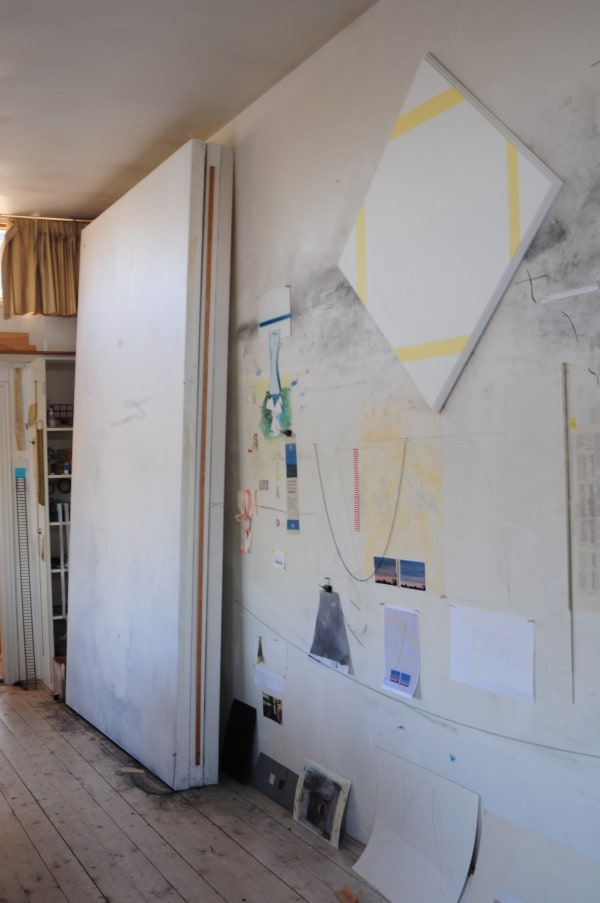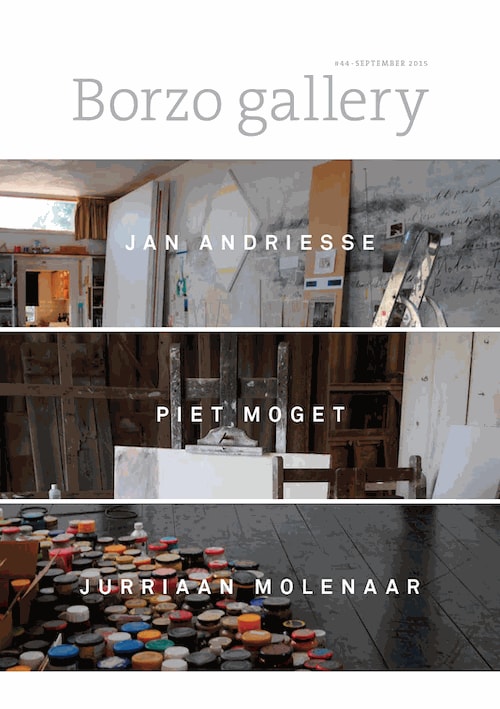Jan Andriesse, Piet Moget and Jurriaan Molenaar
With Piet Moget on the Mediterranean
On the Mediterranean by Port-la-Nouvelle Piet Moget has lived and worked for more than sixty years. For many years now we have visited him every summer. He no longer paints from the Port-la-Nouvelle quayside. The large canvases on the side of his camionette, which served as an easel, have become too much for him to manage. He now paints every day in his open studio, tucked away in a clump of trees on the beach, a few kilometres outside town. It is a rare breed: artists who spend a lifetime captivated by one subject. For Moget this is the sea, or rather that strip on the horizon. He has no need to see the sea directly. He paints from a low viewpoint, sitting in a fairly uncomfortable camping chair, the easel before him at its lowest position. There, where the sky touches the beach, must be the sea. It is nothing more than that thin, almost invisible line between land and sky. Everything is atmosphere.
We drink coffee in Hotel Méditerranée, as he usually does every morning before starting work. He has aged, has some difficulty walking now. We talk about work and the coming exhibition in Amsterdam. All the while, however, his gaze remains fixed on the sea, the beach and the sky. "Can you see how beautiful the light is today? A little bit grey, almost Dutch, and yet far more light". After sixty years Piet Moget is still not tired of it. "I'll be getting back to work now".
We discuss the selection for the exhibition, this time together with Jan Andriesse and Jurriaan Molenaar. Jan Andriesse has often been to Port-la-Nouvelle and has also exhibited in the LAC, the Lieu d'Art Contemporain in neighbouring Sigean. A large and magnificent old building, once a cave coopérative, bought 25 years ago by Piet and converted into exhibition space. Since then he has put on splendid and notable exhibitions together with his daughter Layla. Geer van Velde, Roman Opalka, Robert Morris, Marlene Dumas to name but a few. "Jan Andriesse, a very good artist, one of the best", Piet confides to me.
With Jan Andriesse on the Amstel
A couple of weeks before this I pay another visit to Jan Andriesse. His studio, a houseboat on the River Amstel, lies strewn with huge geographic maps. Pinned to a board a map of the Indonesian Archipelago, where Andriesse was born in 1950. Jan has used drawing pins to hang a chain across it, which follows the line of this 'String of Emeralds' astonishingly well. The wall opposite a large window overlooking the water is one enormous mood board: full of texts, cuttings, drawn lines and sketches. The line fascinates Andriesse. The hyperbola, the parabola, the catenary, geographic lines on a map. "Did you know that the borders of the state of Wyoming in the USA are not natural, but entirely determined by degrees of longitude and latitude? ….and have you seen the chain in The Goldfinch by Fabritius? …..and in that enigmatic Torrentius still life in the Rijksmuseum?"
We talk about the architectural ideas of Gaúdi, who employed the principles of the catenary (the curve a hanging chain naturally assumes) when designing the Sagrada Família. The golden section and the laws of Pythagoras and Kepler are like old friends to him. Painter, philosopher, mathematician probably, but certainly artist with an extraordinary sense of beauty. On the wall hangs a replica a Mondrian he has painted. "I have now made four; only the yellow varies slightly". With the aid of an accurately drawn and cut out stencil Jan shows me what fascinates him so much in this Mondrian. When correctly masked and cut open, the stencil he has made demonstrates how Mondrian sized and composed the four points of the diamond-shaped painting. A huge canvas with the surface painted using numerous layers of atmospheric white - a sort of cloud blanket - has an imaginary catenary. Mysterious small, red stickers - they prove to be the closing tapes from packs of rolling tobacco - mark the position of this chain line. After all, cartographic lines are never visible in the real world.
Study, research and analysis keep Andriesse busy for a large part of every day. With the result that only a very few paintings are completed in consequence. Painting from a strongly conceptual and intellectual perspective, but equally from a great respect for the Old Masters and their ideas about light, composition and colour.
With Jurriaan Molenaar in Weesp
The studio of Jurriaan Molenaar is extremely neat, the walls clean and straight, his large worktable tidy. On the floor stand hundreds of pots of pigment, a sea of colour almost incongruous in this austere 'architecture studio'. Line, light and space define the image in the paintings of Jurriaan Molenaar. Empty spaces preferably. Architecture, even more so: space fascinates him, especially on the flat surface, the canvas.
This 'science-man' has mastered the laws of perspective and geometry down to the finest details. Windows in a wall, a swimming pool, an open door. They are like tests in traditional geometry with the complication of different vanishing points. Molenaar looks for leeway in the geometry, leeway in the perspective and the vanishing points, without, however, violating these. At first sight very realistically represented, further insight reveals that there is nevertheless a slight torsion in the shape of the swimming pool and the aspect of the window in the wall is almost implausible; leeway in what seems real. In Molenaar's paintings colours are restrained and monochrome. In order to suggest depth or light he uses no changes of tone or colour. The areas of colour are, however, painted with extreme precision, and also remarkable sensitivity: every brush stroke is visible. And this is where the warmth lies, the poetry, for the contemplative viewer. Soon after graduating from the Amsterdam Rijksacademie, in 1996 Jurriaan Molenaar was given his first exhibition at Art & Project and this was when his artistic friendship with Jan Andriesse also arose.
With Borzo in Amsterdam
Three artists linked together in a sort of eternal triangle, not only through personal ties, but at least as much through similarities in theme, content and intellect. This will be good to see.
Paul van Rosmalen
'in de Provence'
August 2015















